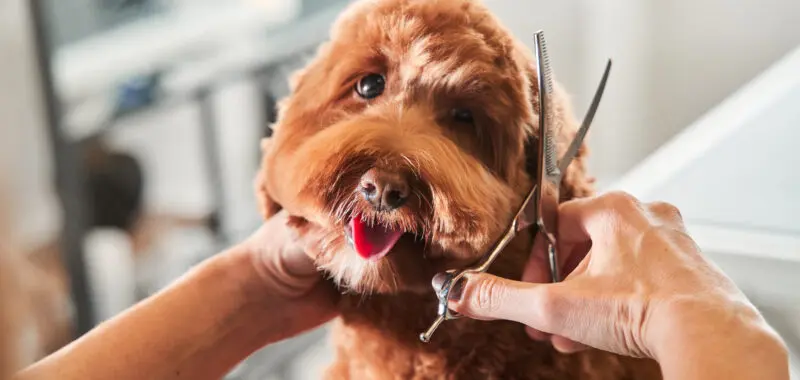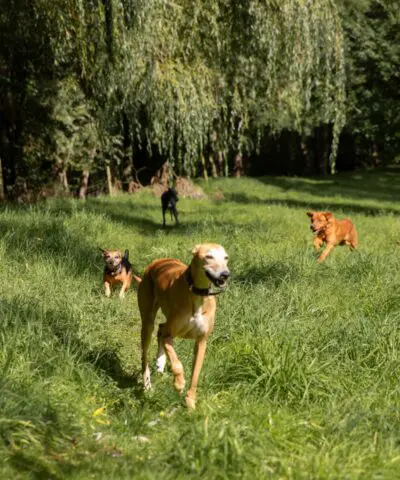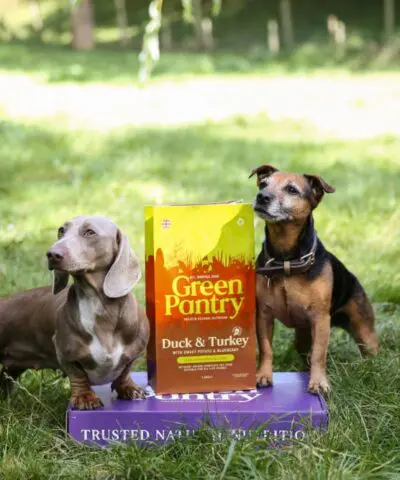If you’ve started to notice a few little white flakes on your dog’s fur, then you might be wondering ‘Why does my dog have dandruff?’ Dog dandruff can be a common concern among pet owners, but don’t worry, as you’re in the right place. In this blog, we’ll talk you through dandruff causes, treatments, and the most common questions, ensuring that your pooch lives a fulfilled and itch-free life.
At Green Pantry, we believe in nurturing our pets from the inside out, and that includes them having a healthy, flake-free coat. Our natural dog food recipes are tailored to address specific health requirements, including those dogs that suffer from a dry, itchy coat.
Ready to scratch the itch on your dog’s flaky skin? Let’s get into it!
Can dogs get dandruff?
Yes, dogs can get dandruff, just like humans! And, it’s actually quite a common skin condition. Dandruff relates to the sebaceous glands, which help to produce skin oils. Seborrhea in dogs occurs when these glands produce too much oil, resulting in an imbalance and producing what people resemble as dandruff – small, white flakes of skin.
Dog dandruff is usually a sign of an irregularity with your pet’s skin and can cause dryness, itching, and irritation. If left untreated, it can damage healthy skin and coats. Luckily, pet dandruff is pretty easy to detect. It usually appears as small, white flakes that cling to your dog’s fur. These flakes can also fall off and attach to bedding, upholstery, and a variety of other household items.
Signs to look out for include:
- White, grey, or yellowish flakes of skin
- Dryness, redness, or inflammation
- Scaly or crusty patches
- Oily skin
- Dullness or lacklustre in their coat
- An unusual or foul odour
Another giveaway that your dog might have dandruff is if they’re constantly licking, biting, or scratching their skin. If a more severe issue is present, you might also notice redness, hair loss, and even a foul odour near the affected areas. While dandruff in itself isn’t harmful, it’s definitely unsightly! Dandruff tends to be a secondary issue, so it is important to get to the root of the problem and treat the underlying cause.
Causes of dandruff in dogs
So, why does my dog have dandruff?
Your dog’s dandruff can come in two forms: dry (seborrhea sicca) and oily (seborrhea olesa). If you have noticed some form of dandruff in your dog, then you might be wondering what has caused it in the first place. Here are some of the most common reasons:
Poor diet
Nutrition plays a pivotal role in your dog’s health, therefore, it’s no surprise that the food they eat can affect a variety of functions, including their energy levels, immune system strength, and, more importantly, their skin health. When it comes to maintaining your dog’s coat, vitamins (especially vitamin A), water, and fatty acids are extremely important. If these components are missing or lacking in your pooch’s diet, dry skin and dandruff may occur.
At Green Pantry, all of our natural dog food and dog treats contain 100% natural ingredients, featuring fresh meat and vegetables such as duck and sweet potatoes, which help to support skin health and coat condition.
Too much or not enough grooming
Grooming your dog is essential, as it helps to maintain overall health and can improve their quality of life! However, it is important to find the right balance. Groom too often, and your dog’s coat can dry out. On the other hand, if you rarely brush and bathe them, then their coat might become too oily. Every dog has unique grooming needs, but the occasional brush and bath can be an effective way to avoid dandruff.
Dry air exposure
You probably didn’t know it, but without enough moisture in the air, your dog’s skin can become dry. If you live in a particularly dry climate, you might have noticed dandruff on your dog’s coat. This may also occur during winter months, which tend to be drier than the rest of the year.
Stress
Although stress itself may not directly create dandruff in a healthy dog, it can create a psychological environment that makes the skin more vulnerable to dryness, irritation, and secondary issues, which may manifest as dandruff. When your dog feels anxious, it can cause hormonal imbalances, alter self-grooming behaviours, and affect their gut health, which can all contribute to dry, flaky skin.
Underlying health conditions
In some cases, dandruff in dogs may be a symptom of an underlying illness. Things like hypothyroidism, autoimmune conditions, and diabetes mellitus can cause inflamed and irritable skin. We highly recommend talking to your veterinarian if you are concerned about your dog’s skin condition.
Allergies
Often, pollens, foods, chemicals, and a wide array of other substances can cause allergies in your dog. When a dog has an allergic reaction, their immune system is overreacting to a normally harmless substance, leading to the release of inflammatory chemicals in the skin, causing it to become itchy, red, and irritated. Skin problems are one of the most common signs of allergies in dogs, so consider this if you have started to notice dandruff in your pooch.
Treatments for dog dandruff
Preventative steps can stop doggy dandruff before it starts. At a glance, some of the things you can do to treat dandruff in your dog include:
- Topical treatments, such as medication shampoos
- Dietary management
- Regular brushing
- Managing their allergens
- Reducing stress factors
Let’s look at some dandruff solutions in a bit more detail…
1. Grooming
As we’ve mentioned above, brushing your pup with an appropriate brush or comb can help to keep their skin and coat healthy and shiny, which can help to prevent dandruff in the first place. If your dog is already showing signs of dandruff, a brush or comb will help to remove the dry flakes. Find out about the importance of regular grooming by reading our expert interview with Laura Denby.
Remember – avoid over-brushing and over-grooming. Excessive brushing, especially with stiff-bristled brushes or too much force, can strip away the natural oils from your dog’s coat.
2. A healthy, balanced diet
A balanced and healthy diet works as a great natural treatment for dandruff in dogs because it directly addresses the nutritional needs of the skin and coat. A dog food that is rich in essential fatty acids and high in protein, vitamins and minerals can help to lock in moisture in the skin, preventing dryness and flakiness. Our range of natural dry dog food here at Green Pantry includes only 100% natural ingredients – take a look at what’s in the pantry here.
Or, give our sample packs a go to see if you can notice a significant difference in your dog’s coat before investing in a full bag.
3. Medicated shampoos
When you bathe your pooch, make sure that you are choosing a shampoo that doesn’t strip your dog’s coat of its natural oils, and avoid using human shampoos because human hair care products aren’t formulated for a dog’s pH levels. You can get specially designed shampoo that tackles dandruff, which is available in most pet stores or online. You can also get medicated shampoos from your veterinarian if you are deeply concerned about your dog’s coat and if other treatments haven’t worked.
4. Use a humidifier
As we know, dry air can be a cause of dandruff. If you have noticed that there is less moisture in your home, especially during those colder months, then you might want to try a humidifier. Humidifiers help to add moisture back into the environment, which will help to prevent your dog’s skin from drying out. A humidifier is not only good for your dog, but it will benefit you as an owner – your skin and hair will thank you for it!
5. Veterinary care
If none of these home remedies are appearing to work, then a trip to the vet might be on the cards. Dandruff is often a symptom of a more significant issue. A vet will be able to perform a thorough examination, ask questions about your dog’s history, diet, and environment, and help to narrow down potential causes.
Molly Norman, owner Groomtastic Dog Spa, Beccles.
‘owners tend to be quite blasé about dandruff without realising it is actually a sign of imbalance. I would always advise that your dog’s outward appearance often reflects what’s going on inside. The skin and coat can be a window into their overall health. Ensure your dog has a healthy diet, eliminate any allergies and keep on top of regular grooming to help prevent dandruff’
Ensure a shinier coat and soft skin with Green Pantry
Hopefully, we have answered your question, ‘Why does my dog have dandruff?’ In essence, dandruff in dogs can be the cause of many external factors, including a poor diet, a lack of moisture, or sometimes underlying health conditions. The best thing you can do for your furry friend is to invest in their diet, give them regular brushes and baths, and ensure that they are kept in a loving and safe environment!
At Green Pantry, we genuinely care about your furry friend’s well-being. Our long-lasting legacy has helped us to become experts in natural nutrition for pets, which is what we use as our driving force to create the highest-quality meals and tasty treats.
For more information, please don’t hesitate to get in touch. A member of our team will be more than happy to get back to you or chat with you about any queries on the phone – simply call us on 01553 811 320.
“Good food for skin allergies – Been using Green Pantry Food for a few years now. I have a dog with a skin allergy and no flare-ups with the trout and sweet potato. Rob is so knowledgeable about pet nutrition and really helpful”
“Great food and service – Great food, dog loves it and he’s doing really well on it. His skin is no longer flaky. Products are always sent/delivered quickly with good customer service.”
Frequently asked questions regarding dog dandruff:
Why does my dog have dandruff after a bath?
Dandruff after a bath in dogs can be caused by several factors, including over-bathing, using harsh shampoos, dry skin, allergies, or sometimes even underlying skin conditions or infections. Bathing your dog, especially quite frequently, can strip the skin of its natural oils and cause it to dry out, increasing the amount of dandruff.
How to get rid of dog dandruff?
To combat dog dandruff, we recommend investing in your dog’s diet. Focus on a healthy diet that is rich in fatty acids, as well as brushing your pooch frequently to distribute natural oils. You could also consider using a humidifier or oatmeal-based shampoo. If the dandruff persists, then it’s probably best to consult with your veterinarian.
Can I use dandruff shampoo on my dog?
You can use dog-specific shampoo for your dry skin pooch, especially those formulated for dry or sensitive skin. Look out for shampoos that contain ingredients like oatmeal, which can help to soothe and moisturise. You should not be using human dandruff shampoo on your dog, as it has not been formulated for their skin and could cause irritation or other skin problems.
What is walking dandruff in dogs?
‘Walking dandruff’, also known as cheyletiellosis, is a skin condition in dogs which is caused by Cheyletiella mites that live on the surface of the skin. These mites are small, but can be seen with the naked eye or a magnifying glass, appearing as small white flakes that move around, hence the name ‘walking dandruff’. Regular flea control measures can help prevent the condition.
Should I be worried if my dog has dandruff?
While mild, occasional dandruff in dogs is usually not a cause for concern, persistent or excessive dandruff, especially accompanied by other symptoms like itching, redness, or hair loss, should warrant a vet visit to rule out underlying skin conditions or infections. A large amount of dandruff can indicate a problem with your dog’s ability to groom themselves properly or even an underlying skin condition that requires proper care and treatment.





